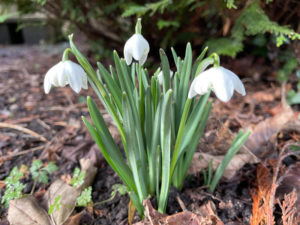 During the darkest days of January the leaves of snowdrops poke their heads through the soil. At the approach of Candlemas they flower and remind us that spring will come eventually. We have several clumps of these delightful flowers growing on the Washpool site and they are increasing year by year. Further down stream there is a lovely drift of snowdrops high on the bank which I am sure many of you will be familiar with.
During the darkest days of January the leaves of snowdrops poke their heads through the soil. At the approach of Candlemas they flower and remind us that spring will come eventually. We have several clumps of these delightful flowers growing on the Washpool site and they are increasing year by year. Further down stream there is a lovely drift of snowdrops high on the bank which I am sure many of you will be familiar with.
Snowdrops are native to continental Europe, growing from the Pyrenees to Ukraine. They have been cultivated in Britain since 1598 and were first recorded growing wild in Britain in the 18th century. Now, the snowdrop is found growing all over the UK although it is rarer in Scotland. Due to commercial harvesting and habitat loss, naturalised snowdrops are legally protected and it is unlawful to collect them from the wild.
Extract of snowdrop was noted by the ancient Greeks for its powerful mind-altering effects.
Although the plant has been used as a traditional medicine since ancient times it has only relatively recently been found to have a pharmacological property.
In the early 1950s a Bulgarian pharmacologist extracted the alkaloid galantamine from the bulb after spotting the locals in a remote village rubbing the plant’s leaves and bulbs on their foreheads to improve memory. Subsequent research proved galantamine to be a useful supplement in the treatment of Alzheimer’s. But as they used to say on Blue Peter, ‘Please don’t try this at home!’
In a German folktale, at the beginning of time the snow was searching for a colour to wear and asked the flowers if it could borrow one of theirs. All of the flowers turned away feeling that the snow was too cold and unpleasant. However, the snowdrop took pity on the snow and offered the snow it’s colour. The snow thus became white and in gratitude allowed the snowdrop to flower at the end of winter by affording it protection and the two now co-exist happily, side by side.
